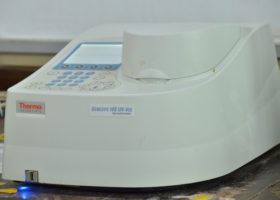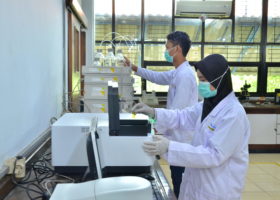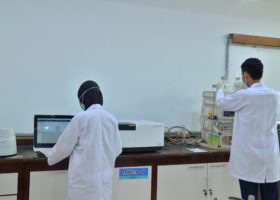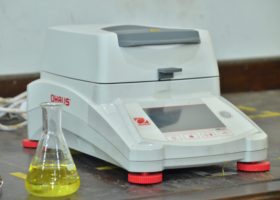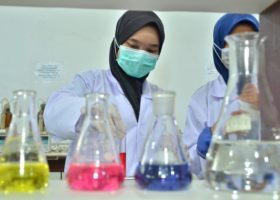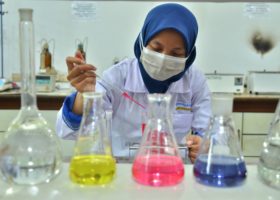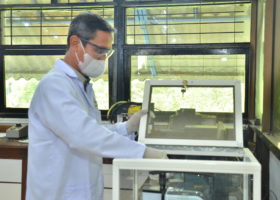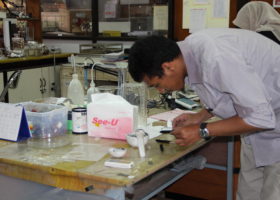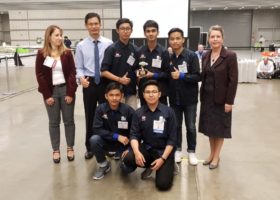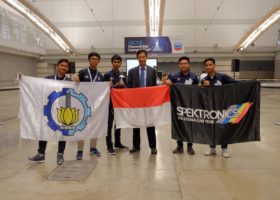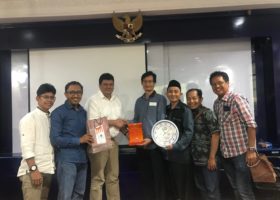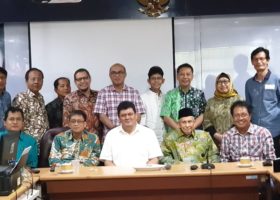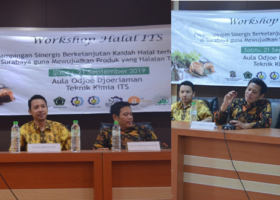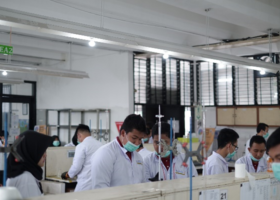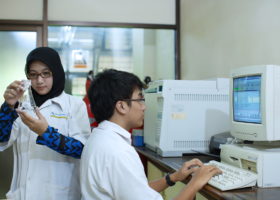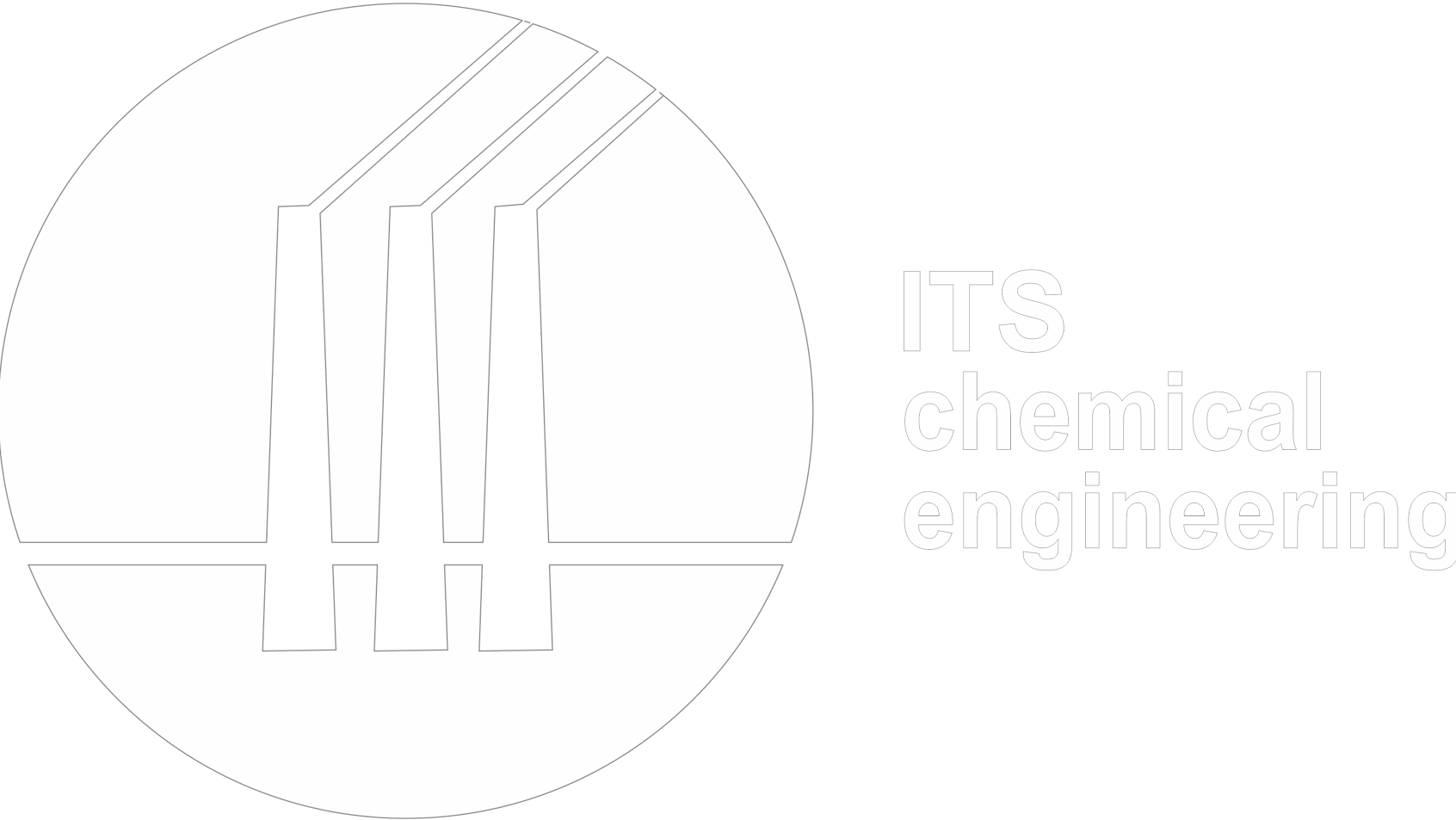| 1 |
FTIRS |
Teknik Kimia |
Laboratorium Pengolahan Limbah Industri dan Biomassa |
Food awareness of college students consumers towards unhealthy snacks: A case study of food colorant at “Bundaran ITS” landmark of Institut Teknologi Sepuluh Nopember (ITSÂ … |
Orchidea Rachmaniah |
2020 |
Y Rahmawati, NMI Suari, F Kurniawansyah, DS Bhuana, EO Ningrum, ... |
(blank) |
IOP Conference Series: Materials Science and Engineering 732 (1), 012065, 2020 |
1 |
| 2 |
FTIRS |
Teknik Kimia |
Laboratorium Pengolahan Limbah Industri dan Biomassa |
Antimicrobial effect of dissolved curcuminoid in natural deep eutectic solvents (NADES) to Escherichia coli and Staphylococcus aureus: A promising candidate for antimicrobial … |
Orchidea Rachmaniah |
2020 |
O Rachmaniah, GRF Gama, ZA Pratama, M Rachimoellah |
(blank) |
Malaysian Journal of Fundamental and Applied Sciences 16 (5), 514-518, 2020 |
1 |
| 3 |
FTIRS |
Teknik Kimia |
Laboratorium Pengolahan Limbah Industri dan Biomassa |
Antimicrobial effect of dissolved curcuminoid in natural deep eutectic solvents (NADES) to Escherichia coli and Staphylococcus aureus: A promising candidate for antimicrobial … |
Orchidea Rachmaniah |
2020 |
O Rachmaniah, GRF Gama, ZA Pratama, M Rachimoellah |
(blank) |
Malaysian Journal of Fundamental and Applied Sciences 16 (5), 514-518 |
1 |
| 4 |
FTIRS |
Teknik Kimia |
Laboratorium Pengolahan Limbah Industri dan Biomassa |
Antimicrobial effect of dissolved curcuminoid in natural deep eutectic solvents (nades) to e. Coli and s. Aureus: A promising candidate for antimicrobial photodynamic therapy … |
Orchidea Rachmaniah |
2020 |
O Rachmaniah, GRF Gama, ZA Pratama, M Rachimoellah |
(blank) |
Malaysian Journal of Fundamental and Applied Sciences 16 (5), 514-518 |
1 |
| 5 |
FTIRS |
Teknik Kimia |
Laboratorium Pengolahan Limbah Industri dan Biomassa |
Production of Liquid Bio-Fertilizer from Old Coconut Water and Molasses using Consortium Microbes |
Raden Darmawan |
2020 |
R Darmawan, VGP Dewi, MA Rizaldi, SR Juliastuti, S Gunawan, ... |
(blank) |
IOP Conference Series: Materials Science and Engineering 845 (1), 012007 |
1 |
| 6 |
FTIRS |
Teknik Kimia |
Laboratorium Pengolahan Limbah Industri dan Biomassa |
Production of Liquid Bio-Fertilizer from Old Coconut Water and Molasses using Consortium Microbes |
Sri Rachmania Juliastuti |
2020 |
R Darmawan, VGP Dewi, MA Rizaldi, SR Juliastuti, S Gunawan, ... |
(blank) |
IOP Conference Series: Materials Science and Engineering 845 (1), 012007 |
1 |
| 7 |
FTIRS |
Teknik Kimia |
Laboratorium Pengolahan Limbah Industri dan Biomassa |
The effects of crude C. inophyllum seed oil to silica gel mass ratio and number of stages on the isolation of wax |
Raden Darmawan |
2020 |
S Gunawan, S Hapsari, HW Aparamarta, K Kuswandi, R Darmawan |
(blank) |
Malaysian Journal of Fundamental and Applied Sciences 16 (3), 363-367 |
1 |
| 8 |
FTIRS |
Teknik Kimia |
Laboratorium Pengolahan Limbah Industri dan Biomassa |
Study of electrode modification and microbial concentration for microbial fuel cell effectivity from molasses waste and reduction of heavy metal Cr (VI) by continue dual … |
Sri Rachmania Juliastuti |
2020 |
IF Nuryana, R Puspitasari, SR Juliastuti |
(blank) |
IOP Conference Series: Materials Science and Engineering 823 (1), 012016 |
1 |
| 9 |
FTIRS |
Teknik Kimia |
Laboratorium Pengolahan Limbah Industri dan Biomassa |
Central composite design based statistical modelling of curcuminoids extraction from Curcuma zedoaria using choline chloride based Natural Deep Eutectic Solvent (NADES) |
Orchidea Rachmaniah |
2020 |
O Rachmaniah, M Rachimoellah |
(blank) |
IOP Conference Series: Materials Science and Engineering 823 (1), 012011 |
1 |
| 10 |
FTIRS |
Teknik Kimia |
Laboratorium Pengolahan Limbah Industri dan Biomassa |
The effect of connection type in series and parallel on electric power generation of mud microbial fuel cell |
Raden Darmawan |
2020 |
M Tominaga, S Ototani, R Darmawan |
(blank) |
AIP Conference Proceedings 2230 (1), 030002 |
1 |
| 11 |
FTIRS |
Teknik Kimia |
Laboratorium Pengolahan Limbah Industri dan Biomassa |
Pendampingan produk umkm di sukolilo menuju sertifikasi halalan thayyiban |
Raden Darmawan |
2020 |
S Gunawan, R Darmawan, J Juwari, L Qadariyah, H Wirawasista, ... |
(blank) |
SEWAGATI 4 (1), 14-19 |
1 |
| 12 |
FTIRS |
Teknik Kimia |
Laboratorium Pengolahan Limbah Industri dan Biomassa |
Proses Pembuatan Asam Sitrat dari Molasses dengan Metode Submerged Fermentation |
Raden Darmawan |
2020 |
IW Amalia, D Nurnanda, N Hendrianie, R Darmawan |
(blank) |
Jurnal Teknik ITS 8 (2), F145-F149 |
1 |
| 13 |
FTIRS |
Teknik Kimia |
Laboratorium Pengolahan Limbah Industri dan Biomassa |
Proses Pembuatan Asam Sitrat dari Molasses dengan Metode Submerged Fermentation |
Nuniek Hendrianie |
2020 |
IW Amalia, D Nurnanda, N Hendrianie, R Darmawan |
(blank) |
Jurnal Teknik ITS 8 (2), F145-F149 |
1 |
| 14 |
FTIRS |
Teknik Kimia |
Laboratorium Pengolahan Limbah Industri dan Biomassa |
Process development for the enrichment of curcuminoids in the extract of ionic type of NADES |
Orchidea Rachmaniah |
2020 |
O Rachmaniah, MR Muhsin, AP Widya, M Rachimoellah |
(blank) |
IOP Conference Series: Materials Science and Engineering 732 (1), 012005 |
1 |
| 15 |
FTIRS |
Teknik Kimia |
Laboratorium Pengolahan Limbah Industri dan Biomassa |
Food awareness of college students consumers towards unhealthy snacks: A case study of food colorant at “Bundaran ITS” landmark of Institut Teknologi Sepuluh Nopember (ITSÂ … |
Orchidea Rachmaniah |
2020 |
Y Rahmawati, NMI Suari, F Kurniawansyah, DS Bhuana, EO Ningrum, ... |
(blank) |
IOP Conference Series: Materials Science and Engineering 732 (1), 012065 |
1 |
| 16 |
FTIRS |
Teknik Kimia |
Laboratorium Pengolahan Limbah Industri dan Biomassa |
A low public awareness of illegals red colorants usage: A case study in ketchup and crackers at traditional market of Sukolilo Surabaya |
Orchidea Rachmaniah |
2020 |
O Rachmaniah, Y Rahmawati, NMI Suari, F Kurniawansyah, DS Bhuana, ... |
(blank) |
IOP Conference Series: Materials Science and Engineering 732 (1), 012062 |
1 |
| 17 |
FTIRS |
Teknik Kimia |
Laboratorium Pengolahan Limbah Industri dan Biomassa |
Proses Pembuatan Asam Sitrat dari Molasses dengan Metode Submerged Fermentation |
Raden Darmawan, S.T., M.T. |
2020 |
|
(blank) |
Jurnal Nasional Terakreditasi |
1 |
| 18 |
FTIRS |
Teknik Kimia |
Laboratorium Pengolahan Limbah Industri dan Biomassa |
Pendampingan produk umkm di sukolilo menuju sertifikasi halalan thayyiban |
Raden Darmawan, S.T., M.T. |
2020 |
|
(blank) |
Jurnal Nasional Non-akreditasi |
1 |
| 19 |
FTIRS |
Teknik Kimia |
Laboratorium Pengolahan Limbah Industri dan Biomassa |
Proses Pembuatan Asam Sitrat dari Molasses dengan Metode Submerged Fermentation |
Ir. Nuniek Hendrianie, M.T. |
2020 |
|
(blank) |
Jurnal Nasional Terakreditasi |
1 |
| 20 |
FTIRS |
Teknik Kimia |
Laboratorium Pengolahan Limbah Industri dan Biomassa |
The effects of crude C. inophyllum seed oil to silica gel mass ratio and number of stages on the isolation of wax |
Raden Darmawan |
2020 |
Gunawan S. |
16 |
Malaysian Journal of Fundamental and Applied Sciences |
1 |
| 21 |
FTIRS |
Teknik Kimia |
Laboratorium Pengolahan Limbah Industri dan Biomassa |
Antimicrobial effect of dissolved curcuminoid in natural deep eutectic solvents (NADES) to Escherichia coli and Staphylococcus aureus: A promising candidate for antimicrobial photodynamic therapy (aPDT) |
Orchidea Rachmaniah |
2020 |
Rachmaniah O. |
16 |
Malaysian Journal of Fundamental and Applied Sciences |
1 |
| 22 |
FTIRS |
Teknik Kimia |
Laboratorium Pengolahan Limbah Industri dan Biomassa |
The effect of connection type in series and parallel on electric power generation of mud microbial fuel cell |
Raden Darmawan |
2020 |
Tominaga M. |
2230 |
AIP Conference Proceedings |
1 |
| 23 |
FTIRS |
Teknik Kimia |
Laboratorium Pengolahan Limbah Industri dan Biomassa |
Production of liquid bio-fertilizer from old coconut water and molasses using consortium microbes |
Sri Rachmania Juliastuti |
2020 |
Darmawan R. |
845 |
IOP Conference Series: Materials Science and Engineering |
1 |
| 24 |
FTIRS |
Teknik Kimia |
Laboratorium Pengolahan Limbah Industri dan Biomassa |
Production of liquid bio-fertilizer from old coconut water and molasses using consortium microbes |
Raden Darmawan |
2020 |
Darmawan R. |
845 |
IOP Conference Series: Materials Science and Engineering |
1 |
| 25 |
FTIRS |
Teknik Kimia |
Laboratorium Pengolahan Limbah Industri dan Biomassa |
Study of electrode modification and microbial concentration for microbial fuel cell effectivity from molasses waste and reduction of heavy metal Cr (VI) by continue dual chamber reactor |
Sri Rachmania Juliastuti |
2020 |
Nuryana I.F. |
823 |
IOP Conference Series: Materials Science and Engineering |
1 |
| 26 |
FTIRS |
Teknik Kimia |
Laboratorium Pengolahan Limbah Industri dan Biomassa |
Central composite design based statistical modelling of curcuminoids extraction from Curcuma zedoaria using choline chloride based Natural Deep Eutectic Solvent (NADES) |
Orchidea Rachmaniah |
2020 |
Rachmaniah O. |
823 |
IOP Conference Series: Materials Science and Engineering |
1 |
| 27 |
FTIRS |
Teknik Kimia |
Laboratorium Pengolahan Limbah Industri dan Biomassa |
Food awareness of college students consumers towards unhealthy snacks: A case study of food colorant at "bundaran ITS" landmark of Institut Teknologi Sepuluh Nopember (ITS) Surabaya during Ramadhan festival |
Orchidea Rachmaniah |
2020 |
Rahmawati Y. |
732 |
IOP Conference Series: Materials Science and Engineering |
1 |
| 28 |
FTIRS |
Teknik Kimia |
Laboratorium Pengolahan Limbah Industri dan Biomassa |
Process development for the enrichment of curcuminoids in the extract of ionic type of NADES |
Orchidea Rachmaniah |
2020 |
Rachmaniah O. |
732 |
IOP Conference Series: Materials Science and Engineering |
1 |
| 29 |
FTIRS |
Teknik Kimia |
Laboratorium Pengolahan Limbah Industri dan Biomassa |
A low public awareness of illegals red colorants usage: A case study in ketchup and crackers at traditional market of Sukolilo Surabaya |
Orchidea Rachmaniah |
2020 |
Rachmaniah O. |
732 |
IOP Conference Series: Materials Science and Engineering |
1 |
